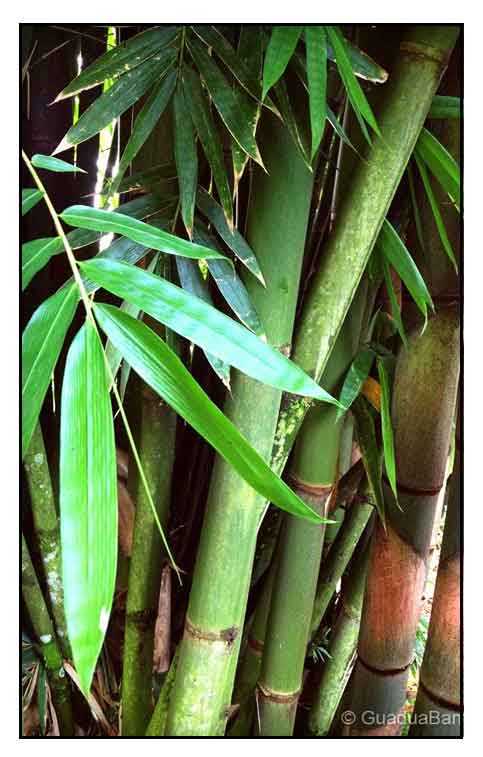 Gen info Gen info
-
As of 2000, there were 62 known bamboo species in the Philippines. Of these, 21 are endemic or native Philippine bamboos; 13 are climbers and 8 are erect. (3)
-
The rest are introduced; a few introduced in prehistoric times.
- There are more than a 1000 different bamboos worldwide.
- Bamboo, a type of grass, is the fastest growing plant in the world. Some varieties grow at a peak rate of 5 centimeters (2 inches) per hour; more commonly about 10 centimeters per day. (3) (4)
- Gigantochloa atter is a bamboo species belonging to the genus Gigantochloa. It is native to Southeast Asia, but has become naturalized all over South Asia. (9)
- In indonesia, the average yield of a G. atter clump is 5-7 culms per year, or, with 200 clumps per ha, 1200-1400 culms per ha per year. (5)
Botany
Kayali is a densely tufted, sympodial bamboo. Culms grow up to 25 meters high, 5 to 10 cm in diameter, about 8 mm thick, bluish-green with distinct pale rings on the nodes; internodes are 40 to 50 cm long, on the upper part with dark-brown appressed hairs, the lower nodes with a few aerial roots. Branches arise from the nodes above 2 to 3 m from the ground. Culm sheath are narrowly triangular with truncate apex, 21 to 36 cm long, black hairy on the outer side. Blades are lanceolate, about 10 cm by 3 cm, deflexed, deciduous, ligue 3 to 6 mm long, irregularly toothed. Young shoots are slender, green to dark green, with appressed black hairs. Leaf blade oblong lanceolate, 20 to 44 cm by 3 to 9 cm, glabrous, lugule2 mm long, auricles firm and low, 2 mm by 1 mm. Inflorescence are borne on leafy branches, with 35 pseudospikelets at the nodes; spikelets are ovoid-lanceolate, 9 to 12 mm by 3 to 4 mm, containing 4 perfect florets and one terminal imperfect one. Caryopsis unknown. (Pl@ntUse) (5)
Distribution
- Native to the Philippines.
- Also native to Borneo, Jawa, Lesser Sunda Is., Maluku, New Guinea, Sulawesi, Sumatera, Vietnam.(1)
- Found in natural stands and in cultivation in the provinces of Davao, Surigao, Bukidnon, Samar, and Leyte.
 Constituents Constituents
- Leaves yield saponins and tannins. (see study below) (6)
- Extraction for total flavonoid content (TFC) for G. atter and G. verticillate revealed values in the range of 84.03 to 92.67 mg QE/g, respectively.
Properties
- Culm is green with purple patches when young, purplish-black when mature.
-
Study of leaves suggest antioxidant, radical scavenging activity.
Parts used
Leaves.
Uses
Edibilty
- Young shoots consumed as vegetable.
Folkloric
- No reported folkloric medicinal use in the Philippines.
Others
- Crafts: Used for making musical instruments.
- Construction / Utensils: Culms for construction as framework, fences, walls. Also used for making household items like beds, cooking utensils, meal skewers, chopsticks, toothpicks, and handicrafts. In West Java, used as substitute for bamboo musical instruments when culms of G. atroviolacea Widaha are not available.
Studies
• Antioxidant / DPPH-Scavenging / Phenolic Content / Leaves: Study evaluated the extractive contents, phenolic content, and DPPH-scavenging activity of various leaf extracts of 3 commonly cultivated bamboo species (Gigantochloa atter, Dendrocalamus asper, and G. verticillata). Hot water produced highest yields of G. atter (3.62%) and D. asper (3.16). Phytochemical screening detected saponins in the hot water extract of G. atter and tannins in the 70% ethanol extract. Resullts showed all 3 bamboo leaf extracts have potential as natural sources of antioxidants and phytochemicals. (6)
• Gigantochloa Bamboo-Derived Biochar for Removal of Methylene Blue: Locally grown bamboo (Gigantochloa spp) was used as feedstock for pyrolysis production of biochar under various pyrolysis temperatures (400-800°C). Resultant biochars were tested fro absorptive removal of methylene blue (MB) dye. Biochar pyrolysed at 500°C (BC500) has highest adsorptive performance with maximum adsorption capacity of 86.6 mg g. FTIR abd SEM confirmed adsorption of MB onto the biochar, while BETdata showed reduction of BET surface are, total pore volume, and pore diameter after adsorption process. (10)
Availability
Wild-crafted.
Cultivated. |

![]()





